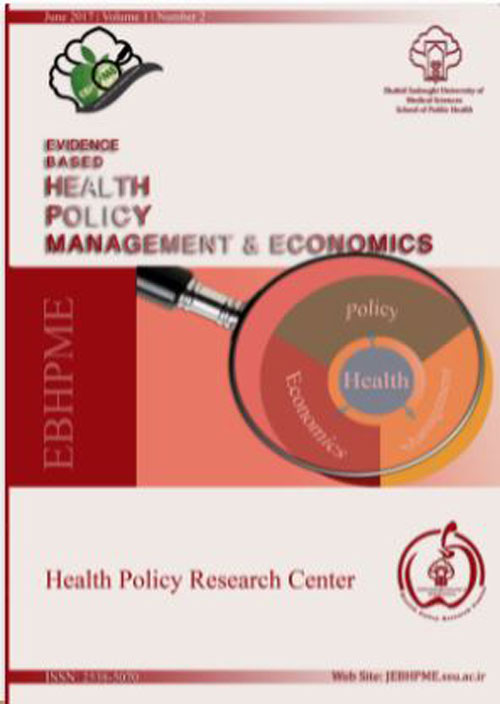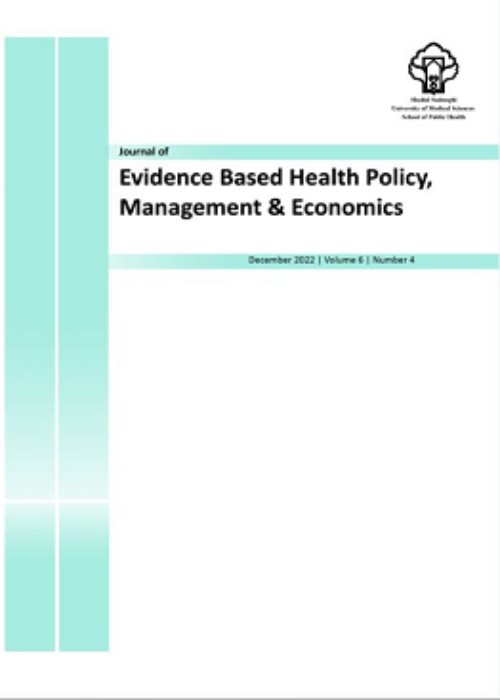فهرست مطالب

Journal of Evidence Based Health Policy, Management and Economics
Volume:5 Issue: 3, Sep 2021
- تاریخ انتشار: 1400/07/20
- تعداد عناوین: 8
-
Pages 151-152
vaginal infection is one of the prevalent problems among the women especially at the age of pregnancy. It can cause death and other complications such as cervical cancer, abortion, premature birth, and infertility. Different infectious organisms can affect the female reproductive system, and almost 95 % of vaginal infections are caused by Candida albicans, Gardnerella vaginalis, and Trichomonas vaginalis microorganisms. Vaginal infections do not usually have any symptom; however, symptoms such as vaginal discharge, irritation, itching, and smelly vaginal discharge can indicate vaginal infection (1). In the health evaluation visit from Sibo Soran city in Sistan & Baluchestan province in East of Iran, qualitative interviews with health staff and the native women revealed that the prevalence of vaginal infections is increasing in this region; the interviewees mentioned the causes of this prevalence as inobservance of healthy behaviors and hygiene, urinary habits, sexual behaviors, eating habits, lack of diagnostic equipment’s, limited access to healthy water, and the low level of health literacy in this city. Nowadays, health literacy is considered as a fundamental indicator affecting the results and the costs of healthcare services, and it is also a requisite for healthcare systems. Health literacy is widely considered as a health determinant and a prioritized issue in public health policies. Low health literacy is related to low health, extensive inequality, and higher costs of health system. Health literacy enables the individuals to play a more active role in changing their surrounding environment to affect health level (2).
Keywords: Health literacy, Vaginal infection, Health policy making -
Pages 153-156
During the COVID-19 pandemic, patients with better general conditions are sent to their own homes for self-quarantine due to a lack of resources in the health system, especially the lack of beds and human resources. Improving patient care may force households to inevitably use home care services, which can be examined from the health equity perspective. In the first step, home care services should be expanded by medical universities in all regions of the country, including less developed areas. In the second step, the financial protection of the recipients of these services should be provided through interventions, such as health insurance coverage. In addition, after the COVID-19 pandemic (post-corona period), it is necessary to organize home care services as soon as possible due to the population aging trend. Finally, despite the problems caused by the COVID-19 pandemic in the country, it is better to use the challenges, actions, and lessons learned from this crisis to complete the infrastructure of the health system in various ways.
Keywords: COVID-19, Health economics, Health equity, Home care, Iran -
Pages 157-165Background
Cost of Quality is an approach that helps organizations evaluate the extent to which their resources are used to prevent poor quality activities, assess the quality of provided services, or evaluate the number of resources that are wasted due to the internal and external failures occurring in a system. The research objective was to measure the Cost of Quality(CoQ) in a medical device division of a hospital in Qazvin, Iran.
MethodsWe performed a qualitative study in the medical device division in a public hospital affiliated with Qazvin University of Medical Sciences, Iran in 2020. To measure and report the (CoQ) in the division, the Prevention-Appraisal-Failure (PAF) model was used. Data were collected through document review, semi-structured interview, and group discussion, which were entered into the Excel software to calculate their distribution and frequencies using the descriptive statistics method.
ResultsAmong different cost categories, the highest amount of expenditures belonged to internal and external failure costs. Results also revealed that several factors were responsible for the failures, including lack of knowledge of personnel about the proper use of medical devices; failure to periodically perform calibration on due dates; lack of adequate supervision; stress and work pressure among employees; and lack of managerial commitment toward the importance of preventive maintenance.
ConclusionIn order to decrease the number of failures occurring in a working system, it is required to increase personnelchr('39')s knowledge about the proper use of medical devices, perform calibration of devices on due dates, increase managerial commitment toward preventive and quality appraisal activities and apply systematic supervision.
Keywords: Cost of quality, Medical device division, Prevention, Appraisal, Failure -
Pages 166-175Background
Schools play a crucial role in developing a healthy lifestyle and community participation, especially family participation, which is essential to schools’ success in achieving this role. This study aimed to examine the family/community involvement in schools’ health planning and policymaking from the principal and lead health education teacher in Tabriz, Iran.
MethodsThis cross-sectional study was conducted in 2016. The statistical population included all school principals and lead health education teachers in Tabriz, Iran. A total of 93 schools were included. A systematic random sampling method was used for data collection. Data were collected using the School Health Profiles. The content validity of the profile was revised by an expert involved in school health. The questionnaire’s reliability was calculated by internal consistency and Cronbach’s alpha coefficient. Data were analyzed using SPSS22. Mann-Whitney and Kruskal–Wallis tests were applied to examine the difference between the type of school (in terms of ownership, gender, and grade) and the school’s percentage that attracts family/community participation.
ResultsAccording to the results, only 53.80 % of schools actively collaborated with students’ families in developing and implementing policies and programs related to health school. The majority of schools (83.30 %) provided parents with educational content on nutrition and healthy eating, while only 40 % of them provided parents with educational content on HIV prevention, STD prevention, teen pregnancy prevention, and asthma. Moreover, more than 50 % of schools worked with other staff groups about health education activities. In most schools (73.30 %), health education teachers worked with physical education staff, while in 53.30 % of them, health education teachers worked with nutrition or service staff on health education activities.
ConclusionGiven a low percentage of school and family/community partnerships in school health-promotion programs in most dimensions, comprehensive and integrative planning must be implemented to create engagement and collaboration with other community sectors.
Keywords: Family involvement, Community involvement, School health policy, School health planning -
Pages 176-184Background
Hospitals are considered the most important consumer units in the health system. Based on the effect of the hospital network in optimal and efficient hospital management, this study aimed to identify and explain the role of factors influencing hospital network management in the Iranian Social Security Organization (ISSO).
MethodsThis study was conducted by a mixed method in 2018. First, variables and factors affecting the management of hospital networks were extracted from the literature review and through interviews with 15 experts, and a questionnaire with 40 questions was developed. Then, it was distributed among 448 experts in the healthcare section of the ISSO all over the country, and 405 questionnaires were completed and collected. Data were analyzed via exploratory and confirmatory factor analysis and structural equations using SPSS23 software and AMOS24 software. The validity of the questionnaire was determined via expert judgment (CVRs = 0.40) and reliability was estimated by Cronbachchr('39')s alpha coefficient (α = 0.87).
ResultsBased on the confirmatory factor analysis, financing, monitoring and evaluation, accountability, strategic planning, and decision rights were identified as key factors affecting hospital network management. Financing with standard coefficients of 0.83 had the highest and decision rights with standard coefficients of 0.44 had the lowest effect on hospital network management of the ISSO.
ConclusionTo efficient hospital network management of the ISSO, while emphasizing all identified factors, special attention should be paid to financing and modifying the method of budgeting and using suitable monitoring and evaluation mechanisms.
Keywords: Hospital network, Management, Health system -
Pages 185-193Background
One of the most important requirements for developing a strategic plan is the effective participation of various stakeholders in plan formulation. The aim of present study was the evaluation of stakeholder participation in the strategic plan developing process in selected hospitals in Tehran.
MethodsThis is a cross-sectional study. This study was conducted in selected hospitals at Tehran in 2015. The data collection tool was a researcher made questionnaire consisting of 3 parts: demographic data, stakeholder participation, and attention to the strategic planchr('39')s components. The validity of questionnaire was confirmed by experts, and its reliability was confirmed by Cronbachchr('39')s Alpha test (α = 0.8). The SPSS18 software was used for data analysis. Descriptive statistics (means, standard deviations, and percentages) were calculated.
ResultsThe findings showed that the highest (42.9) and lowest (34.7) mean score of stakeholder participation in the strategic planning formulation was related to "provision required information for planning" and" presentation of gathering and documentation of the plan, "respectively. Hospital managers (91 percent) had the highest involvement, and external stakeholders had the least participation (1.7 percent) in the strategic planning formulation. The least attention is devoted to evaluating the proposed strategieschr('39') feasibility, identifying competitive and strategic differentiation, and identifying stakeholderschr('39') concerns and needs, respectively.
ConclusionStakeholderschr('39') involvement in the formulation of the hospitalschr('39') strategic plan was not favorable, and hospitals were unable or unwilling to benefit from their participation in the program.
Keywords: Strategic plan, Stakeholders, Hospital, Iran -
Pages 194-206Background
Due to the increasing growth of informal and marginal settlements in Iran, the present study was conducted to analyze the contents of upstream national documents regarding city slum in Iran.
MethodsThis qualitative study with content analysis approach was done in 2020. MAXQDA version 12 software and conventional content analysis method was used to analyze the data.
ResultsThe findings of this study could be classified in two main categories and 11 subcategories. The main categories included the policies related to preventing the creation of slum areas, and policies related to providing service and rehabilitation of slum areas. The 11 subcategories included preventing migration from inner cities to slum areas, poverty alleviation, preserving the rural fabric through the village guide plan, balanced distribution of population with landscaping and land development approach, creating green belts around cities, forced confrontation with illegal constructions in slum areas, impulsive phenomenon of social harms, allocation of state financial facilities to organize informal settlements, renovation of informal settlements, creating satellite towns, and providing primary health care services in the form of health care network system.
ConclusionAlthough providing service and rehabilitation of slum areas can play an important role in reducing harm in these areas, policymakers in Iran should be aware of a moral dilemma; since these policies can also encourage the phenomenon of city slum.
Keywords: City slum, Informal settlements, Document analysis, Qualitative study, Iran -
Pages 207-218Background
Identifying the key factors effective on outsourcing can play a significant role in helping healthcare decision makers to present solutions to improve the outsourcing situation. This study was conducted in order to systematically review the factors influencing the decision making to outsource the services of Iranian medical centers.
MethodsData was collected through searching for keywords in Google Scholar, PubMed, Scopus, Web of Science, Science direct, Magiran, SID and Irandoc databases from January 2010 to December 2020. Also, the quality of the studies was measured and verified by three experts utilizing the Strobe checklist. Researchers classified results achieved by the study.
Results10 articles were selected that responded to the studychr('39')s questions. 44 components in seven dimensions including (economic and financial components, components of laws and regulations (legal), components of supervision and control, components of service type, components of executive capability of the organization, components of the external environment of the organization and components human resources) were recognized on the decision to outsource services in medical centers in Iran.
ConclusionPolicy makers at the decision-making level and managers at the executive level should consider the efficient components and dimensions before deciding to execute outsourcing in units according to the wanted structure, process and consequences, and then make the needed decision regarding the implementation.
Keywords: Outsourcing, Ward, Hospital, Medical centers, Iran


